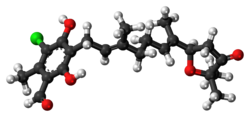 | |
 | |
| Names | |
|---|---|
| Preferred IUPAC name 3-Chloro-5-{(2E,6E)-7-[(2S)-5,5-dimethyl-4-oxooxolan-2-yl]-3-methylocta-2,6-dien-1-yl}-4,6-dihydroxy-2-methylbenzaldehyde | |
| Other names Ascofuranon | |
| Identifiers | |
3D model (JSmol) | |
| ChEBI | |
| ChEMBL | |
| ChemSpider | |
PubChem CID | |
| UNII | |
CompTox Dashboard (EPA) | |
| |
| |
| Properties | |
| C23H29ClO5 | |
| Molar mass | 420.93 g·mol−1 |
| Density | 1.207 g/mL |
| Boiling point | 581.2 °C (1,078.2 °F; 854.4 K) |
Except where otherwise noted, data are given for materials in their standard state (at 25 °C [77 °F], 100 kPa). | |
Ascofuranone is an antibiotic produced by various ascomycete fungi including Acremonium sclerotigenum [1] that inhibits the Trypanosoma brucei alternative oxidase and is a lead compound in efforts to produce other drugs targeting this enzyme for the treatment of sleeping sickness. [2] The compound is effective both in vitro cell culture and in infections in mice. [3]
Ascofuranone has also been reported to have anti-tumor activity, [4] and modulate the immune system. [5]
